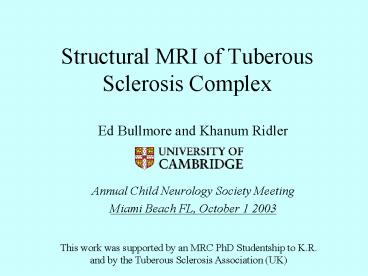Structural MRI of Tuberous Sclerosis Complex - PowerPoint PPT Presentation
1 / 23
Title:
Structural MRI of Tuberous Sclerosis Complex
Description:
Structural MRI of Tuberous Sclerosis Complex. Ed ... Miami Beach FL, October 1 2003 ... work was supported by an MRC PhD Studentship to K.R. and by the Tuberous ... – PowerPoint PPT presentation
Number of Views:167
Avg rating:3.0/5.0
Title: Structural MRI of Tuberous Sclerosis Complex
1
Structural MRI of Tuberous Sclerosis Complex
- Ed Bullmore and Khanum Ridler
- Annual Child Neurology Society Meeting
- Miami Beach FL, October 1 2003
This work was supported by an MRC PhD Studentship
to K.R. and by the Tuberous
Sclerosis Association (UK)
2
Methods of evaluating structural MRI data
- Neuroradiological
- Morphometric
- Region-of-Interest (ROI)
- Computational
Sub-ependymal nodules in PD/T2-weighted FSE data
Cortical tubers in FLAIR data
3
Region of Interest Morphometry
- A prior hypothesis is required - Often not
comprehensive - Labour intensive -
Intra/inter-operator reliabilities lt 1
Accessible to expert information Regions
defined in native space Supports
regional-level factorial modeling, e.g. t-test
4
Computational Morphometry
No prior hypothesis required Comprehensive
Automated Robust and reliable Supports voxel
and cluster level factorial modeling, e.g. 2-way
ANOVA - Not so accessible to expert
information - Standard space mapping
5
Three Steps in a Computational Morphometry
Pipeline
1 Acquire dual echo FSE MRI data 2 Isolate
brain from rest of image 3 Segment or classify
brain into 4 tissue classes grey, white, CSF,
other
1
2
3
6
Two More Steps in Morphometry Pipeline
1. Spatial normalisation Affine transformation
corrects global size and shape differences
between images Non-linear transformations may
additionally correct local size/shape
differences. 2. Statistical modelling and
inference at voxel and cluster levels Permutation
tests, based on repeated random resampling of
the observed data, provide a more flexible and
sensitive approach to hypothesis testing than
theoretical (parametric) methods.
7
Computational morphometric study of neuroanatomy
in people with TSC
Bilaterally symmetric gray matter deficits in
thalamus, basal ganglia and MTL Bilaterally
symmetric white matter deficits in
intrahemispheric fasciculi
- 10 people with TSC versus 8 healthy volunteers
- Group matched for age and sex normal IQ
- PD/T2 weighted MRI at 1.5T
- Computational morphometry affine transform and
permutation tests
Ridler et al (2001) Psych Med
8
Questions motivating further computational
morphometric study of brain structure in TSC
1) Are gray and white matter parenchymal deficits
replicable in an independent case-control
sample? 2) Are gray and white matter deficits
explicable by the distribution of tubers and/or
nodules? 3) What are the psychological
consequences of gray and white matter parenchymal
deficits in people with TSC? Specifically, do
they cause impairment of memory?
9
Second case-control sample
10
Imaging and psychological measurements
Structural MRI at 1.5T PD/T2-weighted FSE data
for computational morphometry and SEN
diagnosis FLAIR data for neuroradiological
diagnosis of tubers and associated white
matter abnormalities Psychological test
battery Motor inhibitory control e.g. stop,
go/no-go Declarative memory recall and
recognition Working memory spatial and verbal
11
Bilaterally symmetric gray matter
deficitscomputational and ROI morphometrics
converge
Gray matter deficits in basal ganglia, thalamus
and cerebellum are significant by voxel-based and
ROI morphometric methods
12
Bilaterally symmetric white matter deficits
13
1) Are gray and white matter parenchymal deficits
in TSC replicable in an independent case-control
sample?
Yes bilaterally symmetric subcortical gray and
intrahemispheric white matter deficits have been
replicated in a second study and seem to be novel
but robust anatomical markers of TSC
2) Are gray and white matter deficits explicable
by the distribution of tubers and nodules?
14
Whole brain mapping of cortical tubers in TSC
Neuroradiologically diagnosed tubers were
distributed symmetrically but not randomly
greatest density of tubers in frontal and
parietal lobes
15
Tubers are slightly correlated but not generally
coincident with gray matter deficits
16
Subependymal nodules are slightly correlated but
not coincident with gray matter deficits
17
Gray matter volumes and tuber/nodule lesion
volumes compared in (sub)cortical regions
18
2) Are gray and white matter deficits explicable
by the distribution of tubers and nodules?
No tuber distribution does not coincide with
pattern of gray or white matter deficit
subependymal nodule distribution more closely
(but not completely) corresponds to gray matter
deficits. Although parenchymal deficits are not
always anatomically coincident with tubers and
nodules they are correlated markers of brain
disorder in TSC.
3) What are the psychological consequences of
gray matter parenchymal deficits in people with
TSC?
19
An uneven profile of cognitive impairment in
IQ-preserved people with TSC
Recall
Working Memory
Recognition
I.P.S.
Inhibition
- Selective deficits in multiple (correlated)
tests of working memory, immediate and delayed
recall from episodic memory - Normal function on tests of motor inhibitory
control, processing speed and recognition memory
20
Memory deficits in TSC are correlated with
subcortical gray matter deficits
-28 -4 1 4 8 12 16 60
Episodic Memory Verbal Working
Memory Spatial Working Memory
Case-Control Comparison
-28 -4 1 4 8 12 16 60
-28 -4 1 4 8 12 16 60
-28 -4 1 4 8 12 16 60
21
Associations between memory and subcortical gray
matter volumes
22
Conclusions
Computational morphometry can complement and add
value to anatomical characterisation of
neurodevelopmental syndromes
Bilaterally symmetric subcortical gray and
intrahemispheric white matter deficits have been
described for the first time and replicated in
two case-control studies of TSC
Tuber and nodule distribution has been mapped in
standard anatomical space for the first time.
Radiologically diagnosed lesions are also
symmetric and correlated with parenchymal
deficits but do not simply explain them.
Even in the context of normal IQ, TSC can be
associated with salient and selective deficits in
memory which are correlated with subcortical gray
matter deficits in basal ganglia and thalamus.
23
Thanks
Khanum Ridler and MRC, UK Ann Hunt and TSA,
UK Nick Higgins John Suckling Patrick
Bolton Martin Graves and MRIS Unit team,
Addenbrookes Hospital, Cambridge UK Volunteers
participating in the studies http//www-bmu.psych
iatry.cam.ac.uk etb23_at_cam.ac.uk or
kr240_at_cam.ac.uk































